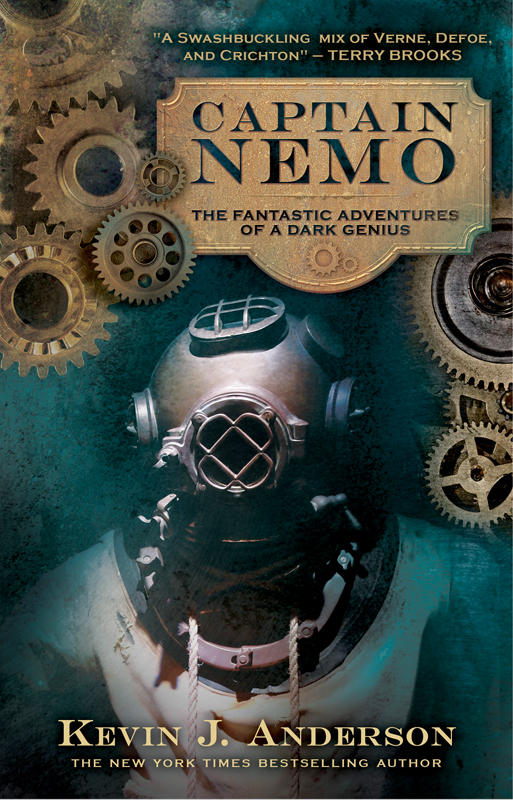Captain Nemo: Fantastic Adventures of a Dark Genius – A Review
Captain Nemo: Fantastic Adventures of a Dark Genius. On sale 9/6/2011, for the first time under the author’s full name, instead of the pseudonym K.J. Anderson.
First published in 2002, Kevin J. Anderson’s most recent release through Titan Publishing Group is a “reboot” style story. What if, instead of a fictional character, Andre Nemo was Jules Verne’s boyhood friend. What if he ran away to sea to make his fortune, and was shipwrecked by pirates? Shenanigans ensue, that’s what.
Let me begin by saying that I was looking forward to this book. I rubbed my hands together, and giggled gleefully at the thought of swashbuckling and invention and fantastic adventures. When the book arrived, I was thrilled! The cover is beautiful, two sprays of copper gears framing a diving helmet.
I am disappointed. Maybe I was expecting too much, but from an author who’s published over 100 novels, I thought I could depend on some research, some good editing and proofreading, and some character development. If those are things you value in your reading matter, avoid this book.
Other reviewers (of the original release) have noted inconsistencies such as the silliness of rewriting Nemo as Verne’s contemporary, and a Frenchman. Others have also discussed the unrealistic plotlines, and name-dropping from Verne’s other stories. I’m going to leave all of that to those people.
My most violent reactions were to three things. First, in the first chapter or so, the third member of the love triangle involving Verne and Nemo, Caroline Aronnax, is described as a rebellious young woman who composes her own music unbeknownst to her parents. This might be possible, although I’ve lived with people who composed before, and you can always tell when they’re working. My issue is with the statement that her mother “tried to reign her in.” I’ll just leave that one right there. I don’t think it needs explanation.
Secondly, after being attacked at sea by pirates, Nemo survives by constructing a raft, and rowing himself to an uninhabited island. Verne, as a parting gift, had left him a copy of Robinson Crusoe, and Nemo’s erstwhile captain, an Englishman named Grant, introduced him to the writings of William Dampier. Dampier, a sometime English privateer and pirate, was the captain who marooned Alexander Selkirk, the inspiration for Crusoe. Now, it’s a couple of chapters in between Grant lending Dampier’s book to Nemo, and the next mention of it, but someone, sometime, should have caught this: “Some poor wretches – such as William Dampier, the original inspiration for Robinson Crusoe – had become more like animals than men after being stranded on desert islands.” I just don’t even have words.
Thirdly – I think this is my largest issue – Nemo is a cardboard cutout boy running around this island, with The Swiss Family Robinson and Robinson Crusoe and diagrams by Da Vinci running through his head, and here is what he does.
First, he scouts for water, food, and shelter. Well done, survivalist. Next, he builds his shelter, takes stock of his supplies, doesn’t throw anything out, and sets about securing a better shelter, and improving his situation. He does this by building a kiln and firing some clay dishes. I’m not arguing the necessity for cooking gear, and he would definitely need something to boil water in, but – kiln-firing pottery is not for the beginner. It’s complicated, and if the dishes aren’t glazed, which is not mentioned, the clay will still be porous, break easily, and harbor food particles and germs. Not good. Also, not a top priority when shipwrecked.
After he’s made his dishes, Nemo finds a system of caves in the beachside cliffs, and crafts himself a handy-dandy hide-out, complete with elevators made of baskets, with which he raises and lowers himself and his supplies. He also pipes in hot and cold water. The elevators, I suppose, are practicable, although I wouldn’t want to try hauling myself up a cliff in a basket without a good pulley, which was not on Nemo’s list of salvage. Piping hot and cold water, though, there my disbelief broke suspension with a crash that probably scared my cat.
Hot and cold water. In pipes. On an uninhabited jungle island. Without a forge, or other means of working metal. This means either he used bamboo or some similar wood, or he magically mined and refined (and other metal-working processes I know exist, but don’t remember the names of,) metal without any previous working knowledge, into pipes which he then laid into his cave-house. I’m going to go with the bamboo option, because it’s remotely possible, but I’m a little puzzled how he got the wood to stay watertight when he had hot water running through it. That’s traditionally a method for making wood bendy.
That’s just the common sense stuff. Other things, like building a huge fire to attract the pirates to his island so as to attack them, without first building a network of traps, snares, etc., around the island, well, Nemo’s only 20 here. I suppose he might live to get smarter.
Poor cardboard Nemo. He does not grow, or change. He moves through the story soaking up all the knowledge he can reach, but not seeming to know how to put the pieces together. Kind of like the piping I guess.
I think the book is best summarized by this paragraph, describing Nemo’s method of invention:
He had done everything by himself, thinking up ideas, designing the pieces, and implementing them. When an idea failed, sometimes disastrously, Nemo went back to his ruminations, his scrawled plans, and refigured the math and engineering. Captain Grant had taught him the fundamentals, and Nemo had learned the rest by trial and error. Luckily, he had lived through the errors…
Kevin J. Anderson has, in my opinion, done everything by himself here, when a little Google work would have given him infinite resources on survival theory and practice. A good editor and some proofreading would have averted some of the rest of the problems. Luckily, (or not,) Nemo lived through all the errors, going his cardboard way, and living his cardboard adventures.




